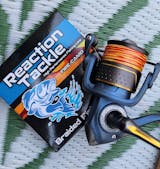
Angling Tactics: An Aquatic Musical
If you've ever felt the rush of a catch or the ache of a near miss, you know there's more to fishing than just luck. It's like a dance, a personal and intricate one between you and the underwater world, where every ripple and tug at the line deepens the connection. In this aquatic symphony, science serves not only as a guide but as a skilled musician, orchestrating each moment with precision and insight.
Let's make our way to the seafloor together, armed with the knowledge to shift the balance of this dance in your favor. By the end you should be geared to transform hopeful casts into triumphant catches and foster moments of connection that resonate with the soul of an angler.
Let’s Talk Fish Basics:
Fish are remarkable creatures—next level amazing. They have an entire suite of senses fine-tuned for life underwater. Ever wonder why you can't seem to fool that bass in crystal clear water, but how you're the champ of catches in the murky depths? It's all about them playing to their strengths, whether it’s their sharp eyesight or keen sense of taste and smell. Knowing what makes them tick can make your bait the next big hit on their menu.
- Sight: In clear water, use lures that closely mimic the appearance of fish prey. Think realistic colors and patterns.
- Smell and Taste: In murky waters, scented baits are your best friend, leaving a trail that fish can't resist following.
What's Up Down Under:
The underwater scene is a dynamic zone where factors like water temperature, light levels, oxygen content, and the season orchestrate fish behavior. The underwater scene is ever-changing, with temperature, light, and oxygen mixing things up. Here's how understanding the environment can up your game:
- Temperature Tips: Fish are more active and feed during warmer temperatures. Hit the water early morning or late evening in warmer months for the best action.
- Oxygen Oasis: Look for areas with moving water, like streams entering a lake or areas churned by wind. These spots are oxygen-rich and attract fish.
Bait and Lures That Dance or Casting the Right Beat:
Selecting the right bait or lure is crucial, much like picking the perfect playlist for a party. If you want to keep the party going, you’ve got to get them on the dancefloor. Here's how to match the vibe of your aquatic audience:
- Color Coding: Bright or flashy lures work best on sunny days, while subdued, natural colors are more effective under overcast skies.
- Vibration Nation: In murky waters, lures that vibrate or make noise can be a game-changer, giving fish another way to home in on your bait.
Rhythms of the Deep: Tapping Into Predator Instincts
Just like a conductor leads an orchestra with precision and flair, you can guide the aquatic symphony to your advantage. Predatory fish, with their innate rhythm for hunting, are naturally drawn to the beat of vulnerable prey. Imagine each cast as a stroke of the conductor's baton, initiating a performance that's irresistible to the underwater audience. Your rod and lure become instruments in this watery concert, playing the erratic melody of an injured fish - a siren song for predators.
- Erratic Energy: To trigger an attack from predators, mimic the erratic movement of injured fish with your lures. Simple jerking or twitching motions with your rod can be incredibly effective, resembling the last efforts of prey struggling to survive. This technique is a direct line to the predatory instincts, making your lure an irresistible target.
Harmonizing with Nature:
Mastering angling is like orchestrating a symphony with nature, where timing, location, and the right lures play key roles. Think of it as choosing the perfect moment for a musical flourish that captures the attention of your audience—the fish. By mirroring the natural flow of the aquatic environment and the seasonal rhythms of your target species, you can increase your chances of success. This approach is about making each cast count, like hitting the right notes in a melody that resonates with the underwater world.
- Seasonal Shifts: Fish adjust their locations with the seasons. In spring and fall, they are typically found closer to shore for spawning and feeding activities. During summer and winter, they often prefer the stable conditions of deeper waters.
- Moon Phases: The phase of the moon affects fish activity levels. Full and new moons can lead to higher tides, which may bring fish closer to shore, offering anglers better fishing opportunities.
As we reel in our journey through the aquatic musical of angling tactics, it's clear that fishing is far more than a simple cast and wait game. It's an art form, a symphony of strategy, knowledge, and intuition, where anglers and fish engage in a dance dictated by the rhythms of nature itself. From the nuanced understanding of fish biology to the strategic deployment of lures and baits, every element harmonizes to create a captivating performance beneath the water's surface.
Let's carry forward the melody of this aquatic adventure, casting our lines with respect and insight into the water's depths. Here's to the continued dance of angling, where every outing is a chance to learn, adapt, and celebrate the beauty of fishing.
Have you felt the rhythm of the river or the melody of the sea guide your fishing adventures? Musical playlists are included! Drop a comment about how you dance with the fish. We're eager to hear from you.










